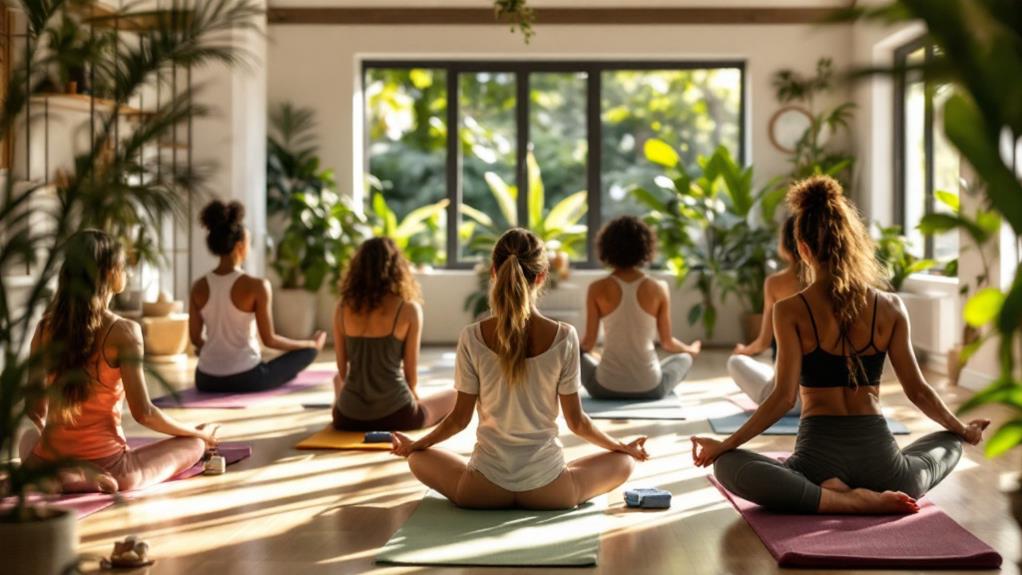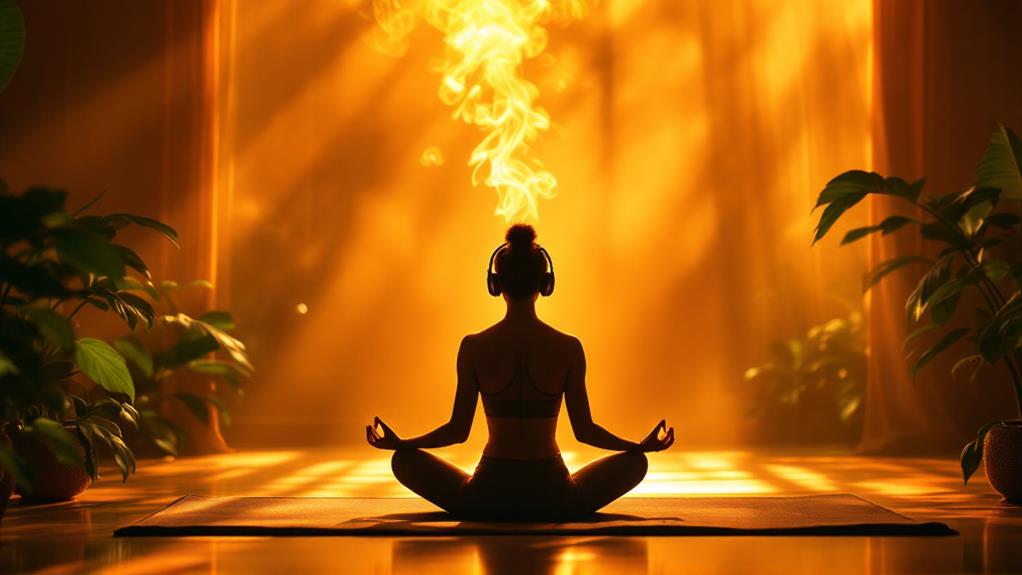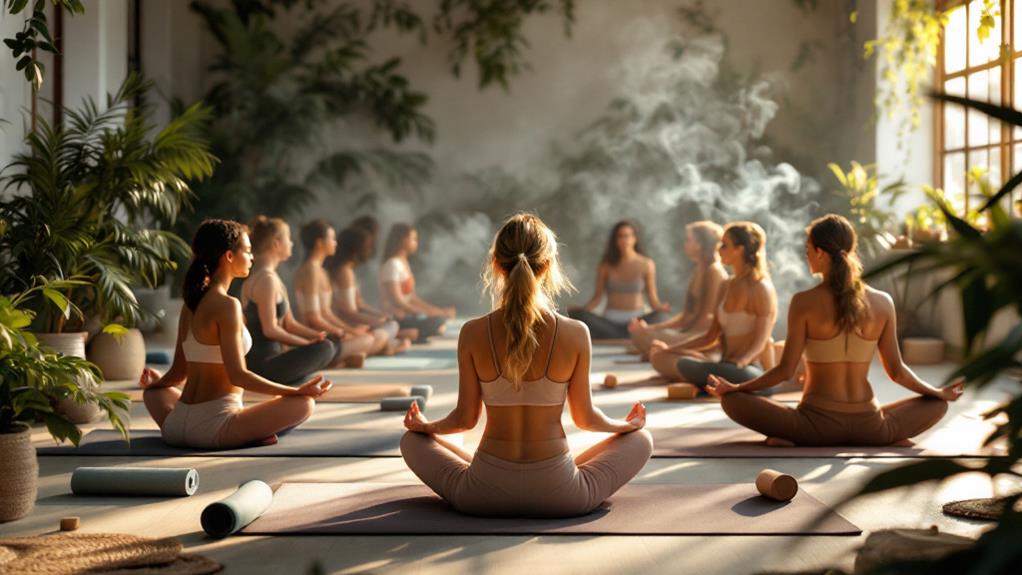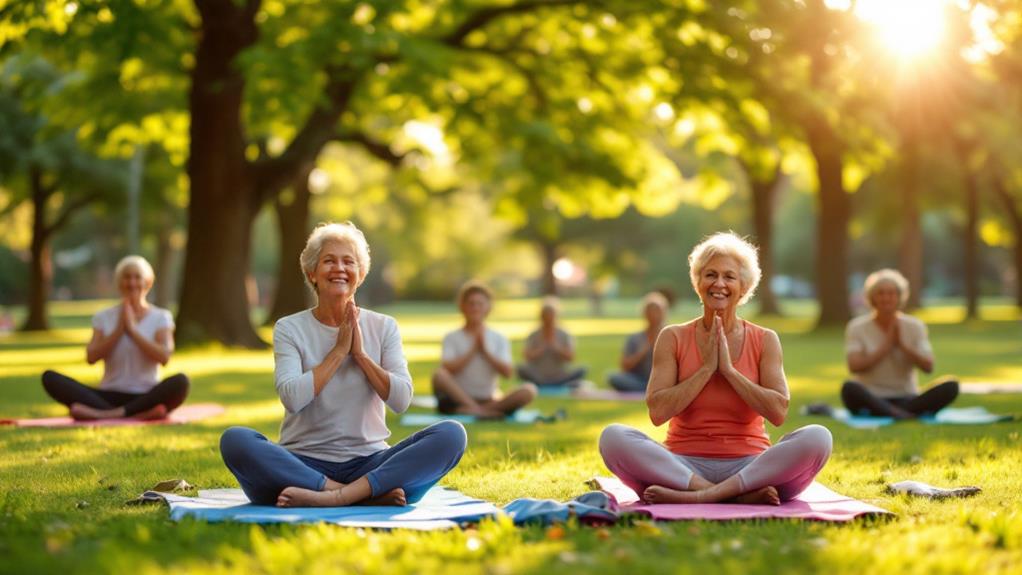What Kind of Yoga Should I Start With? A Beginner’s Guide
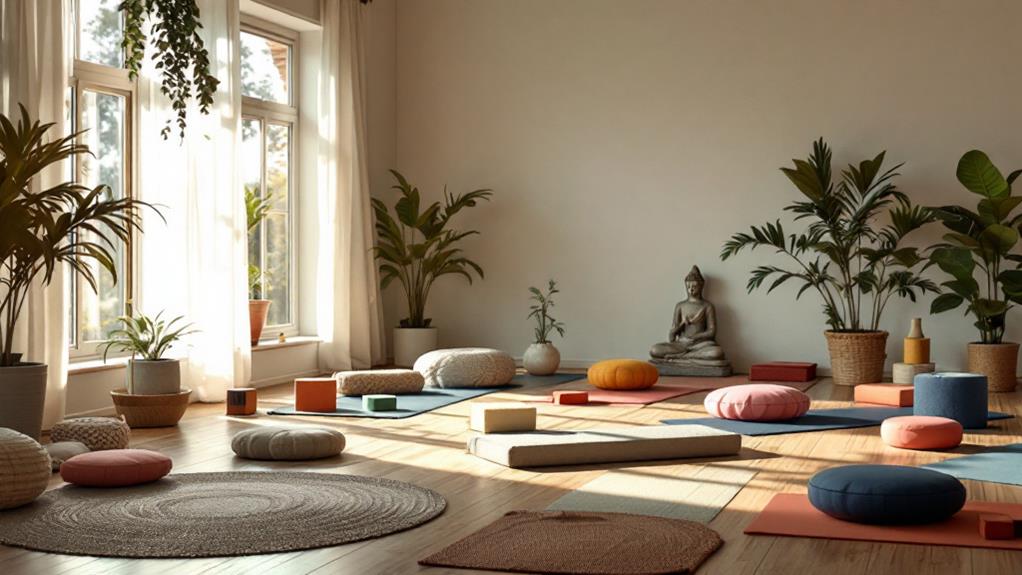
Start your yoga adventure with Hatha yoga, a style that's perfect for beginners. It focuses on foundational poses and breathing techniques at a gentle pace. If you're looking for something dynamic, try Vinyasa, which combines breath with movement. Iyengar is great if you want to improve alignment using props, while Ashtanga offers a structured approach with a fixed sequence of poses. Restorative yoga is ideal for relaxation and stress relief. Choose classes with clear instructions and modifications, and consider trying trial sessions to investigate. Equip yourself with a good yoga mat and blocks, and uncover how different styles can suit your needs.
Understanding Yoga Basics
Yoga, an ancient practice with deep roots in Indian philosophy, offers a holistic approach that unites your mind, body, and spirit. As you commence your yoga expedition, understanding the basics is crucial. Yoga for beginners often starts with types of yoga classes that emphasize fundamental principles. Hatha yoga is a popular choice, focusing on physical postures (asanas) and breathing techniques (pranayama). This style is gentle, making it ideal for those new to yoga.
Restorative yoga is another beginner-friendly option that emphasizes relaxation and stress relief. The use of props and gentle movements helps you ease into postures, allowing the body to release tension. As you practice, you'll notice the benefits of yoga, such as improved flexibility and a calmer mind.
Beginner yoga classes typically guide you through a series of poses designed to build strength and increase awareness of your body. Breathing techniques are integrated to improve the mind-body connection and promote a sense of tranquility. By exploring different types of yoga classes, you can find the practice that best suits your lifestyle and needs, setting a strong foundation for a lifelong expedition in yoga.
Benefits of Practicing Yoga
Incorporating yoga into your routine offers numerous benefits that improve both physical and mental well-being. For beginners, yoga is an excellent practice to improve flexibility and balance, which can elevate your general physical performance and reduce the risk of injury. As you practice, you'll notice advancements in your range of motion and stability, crucial for everyday activities and athletic pursuits.
The benefits of yoga extend beyond the physical. It's highly effective in reducing stress, a common challenge in the current fast-paced world. By practicing yoga, you'll cultivate mindfulness and promote mental clarity, contributing to improved emotional well-being and lower anxiety levels. This mental shift can make a significant difference in how you approach daily stressors.
Moreover, regular yoga practice supports muscle recovery and injury prevention, making it beneficial for not just athletes, but anyone seeking to maintain their health. Yoga's emphasis on breath control techniques improves respiratory function and supports overall wellness, offering a holistic approach to health improvement. Furthermore, studies suggest that yoga can lower cortisol levels, leading to reduced inflammation and better cardiovascular health. As a beginner, embracing these benefits can set a strong foundation for your long-term health path.
Exploring Hatha Yoga
As you start your yoga adventure, exploring different styles can help you find what best suits your needs. Hatha Yoga, often regarded as the most common beginners yoga, is an excellent place to start. This style focuses on foundational poses and a slower pace, making it ideal for those new to the practice. By holding poses for several breaths, you improve strength and flexibility while promoting body awareness.
Hatha Yoga is a physical practice that emphasizes form and alignment, allowing you to explore deeply into each posture's technique. Following an Iyengar-style format, it prioritizes detail in every movement, ensuring that you build a solid foundation. This method doesn't just improve your physical performance; it also contributes greatly to stress reduction. You'll find that the calming nature of this practice helps balance energies and provides a peaceful introduction to yoga.
Regularly engaging in Hatha Yoga can help you develop a keen awareness of your body and improve your general well-being. The focus on alignment and detailed instruction makes it an accessible and rewarding experience for beginners. As you progress, you'll notice improved strength, flexibility, and a greater sense of calm, making Hatha Yoga a great starting point in your yoga expedition.
Vinyasa Yoga Essentials
For those seeking a more dynamic yoga experience, Vinyasa Yoga offers an exhilarating blend of movement and breath. This style is perfect if you enjoy a fast-paced, active practice that keeps you constantly engaged with its dynamic flow. By linking breath with movement, Vinyasa Yoga allows for fluid shifts between poses, making each session unique and exciting. Beginners will find this approach invigorating as it not only builds strength but also improves cardiovascular health through warming sequences.
Here are four reasons why Vinyasa Yoga might be the perfect fit for you:
- Strength and Flexibility: The continuous movement helps build muscle strength and improve flexibility, crucial for an all-round fitness routine.
- Engaging and Varied: Each class offers a different sequence, so you'll never get bored. The unpredictability keeps your mind and body challenged.
- Cardiovascular Health: Vinyasa's active nature boosts your heart rate, which complements endurance training and promotes cardiovascular health.
- Motivating Atmosphere: Many classes incorporate upbeat music to match the energetic flow, making the practice more enjoyable and motivating.
Dive into Vinyasa Yoga, and you'll uncover a dynamic practice that keeps you moving and breathing, improving both body and mind.
Iyengar Yoga Insights
Iyengar Yoga stands out with its focus on precision and alignment, making it ideal for those seeking to master proper form and technique. If you're just starting your yoga expedition, Iyengar Yoga provides a perfect introduction to the practice. It's designed to help beginners build a strong foundation. With the use of props like blocks, straps, and blankets, you can achieve optimal alignment and support. These tools make it easier to hold poses correctly, even if you're dealing with flexibility issues or recovering from an injury.
In Iyengar classes, you'll notice a structured approach that guides you through a systematic progression. You'll hold poses longer, which promotes greater body awareness and a deeper focus on technique. This style is especially beneficial if you're detail-oriented and appreciate a methodical practice. Starting with level one classes will provide you with foundational knowledge, building your confidence as you investigate different poses.
Introduction to Ashtanga
Discipline takes center stage in Ashtanga Yoga, offering a structured and dynamic practice that caters to those who thrive on routine. Ashtanga yoga revolves around a fixed sequence of six series of poses, making it perfect for anyone who enjoys structure. This method places emphasis on synchronized movement and breath, which creates internal heat. This not only detoxifies your body but also improves circulation.
For beginners, Ashtanga can be intense, so patience is key. This practice builds strength and flexibility over time. Start slow and listen to your body to avoid injury. Here's what you can expect:
- Routine and Discipline: You'll follow the same sequence every class, helping you refine your technique and deepen your practice.
- Physically Demanding: It challenges your body, promoting both physical and mental endurance.
- Mysore Style: This offers a personalized approach where you practice independently, but with guidance from an instructor.
- Internal Heat: The synchronized movement with breath generates heat, aiding in detoxification and circulation.
Embrace the path of Ashtanga yoga with patience and discipline, and you'll cultivate not only physical strength but also a deeper understanding of your body and mind.
Discovering Bikram Yoga
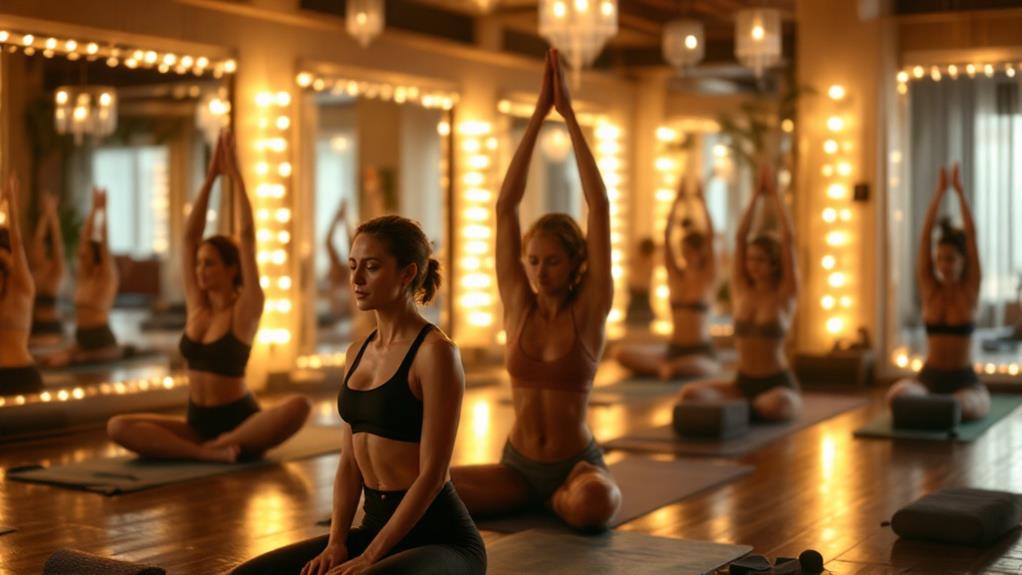
Exploring Bikram Yoga introduces you to a unique and challenging practice that takes place in a heated room, designed to push your limits and promote detoxification. As a beginner, you'll experience a 90-minute sequence of 26 postures and two breathing exercises, all performed in 105°F (40°C) heat with high humidity. This environment amplifies internal heat, helping to increase flexibility and elevate strength, offering significant physical benefits.
The structured routine of Bikram Yoga means every class follows the same sequence, making it easier for newcomers to learn and become familiar with the practice. Over time, this repetition improves comfort and builds confidence, allowing you to focus more on perfecting your postures.
Hydration is key in Bikram Yoga due to the intense heat and physical demands. You'll need to maintain adequate fluid levels before, during, and after your class to counteract rapid fluid loss and support your body's needs.
Beyond the physical aspects, Bikram Yoga is known for relieving stress and improving mental clarity. The combination of physical exertion and mindfulness during practice makes it appealing not only for fitness enthusiasts but also for those seeking mental peace and focus.
Restorative Yoga Techniques
While many yoga practices can be physically demanding, Restorative Yoga offers a gentle alternative focused on relaxation and stress relief. This practice emphasizes passive stretches held for extended periods, usually 5-20 minutes, using props for support and comfort. This approach allows you to unwind, release tension, and promote deep relaxation and rejuvenation. It's an ideal choice for beginners or anyone recovering from injuries, as it involves gentle movements and restorative postures.
In a typical Restorative Yoga session, you'll experience:
- Mindfulness and Breath Awareness: By concentrating on your breath, you can settle your nervous system and improve mental clarity.
- Support and Comfort with Props: Using props like bolsters, blankets, or blocks helps you maintain poses comfortably, ensuring effective relaxation.
- Common Restorative Poses: Poses like Supported Child's Pose, Legs-Up-The-Wall, and Supported Bridge Pose are designed to have a calming effect on your body and mind.
- Deep Relaxation and Stress Relief: Holding these poses allows you to relax deeply, easing stress and promoting a sense of calm.
Restorative Yoga is a nurturing practice that encourages mindfulness and offers a soothing experience for both body and mind.
Choosing the Right Class
After experiencing the calming benefits of Restorative Yoga, you might be enthusiastic to uncover other yoga styles that fit your needs and interests. Hatha Yoga is an excellent starting point, offering a gentler approach with foundational poses and a slower pace. This makes it ideal for beginners seeking to build a solid base. If you're more active, consider Vinyasa Yoga, which combines breath and movement in a dynamic flow, offering an engaging and fun practice.
When choosing the right class, look for beginner-friendly classes that emphasize clear instructions and modifications. This guarantees a supportive environment where you can learn crucial poses and techniques at your own pace. Many studios offer trial classes or introductory packages, allowing you to investigate different styles without a long-term commitment.
Researching instructors is key. Reading reviews can help you find a teacher who aligns with your personal style and learning preferences. This connection can improve your general practice experience, making it more meaningful and enjoyable. By taking the time to find the right class and instructor, you'll set yourself up for a fulfilling yoga expedition.
Essential Yoga Equipment
Starting your yoga expedition requires some vital equipment to improve your practice and guarantee safety. As a beginner, gathering the right tools can elevate your comfort, flexibility, and overall experience. Here's a quick guide to fundamental yoga equipment:
- Yoga Mat: Invest in a high-quality yoga mat to provide comfort and stability. It helps reduce the risk of slipping, ensuring you can safely perform poses on diverse surfaces. A good mat supports smooth movement and proper alignment.
- Yoga Blocks: These are indispensable for beginners, especially if you have limited flexibility. They offer the support needed to achieve proper alignment in poses, helping you build confidence as you progress.
- Straps: Straps extend your reach in certain poses, facilitating deeper stretches and improving posture. They're excellent tools to improve your flexibility and make challenging poses more accessible.
- Breathable Clothing & Water Bottle: Choose stretchy, breathable clothing designed for movement to increase comfort and performance. A comfortable water bottle is vital for staying hydrated before, during, and after sessions, helping maintain energy levels and support muscle recovery.
Arming yourself with these fundamentals will set the foundation for a successful yoga expedition.

